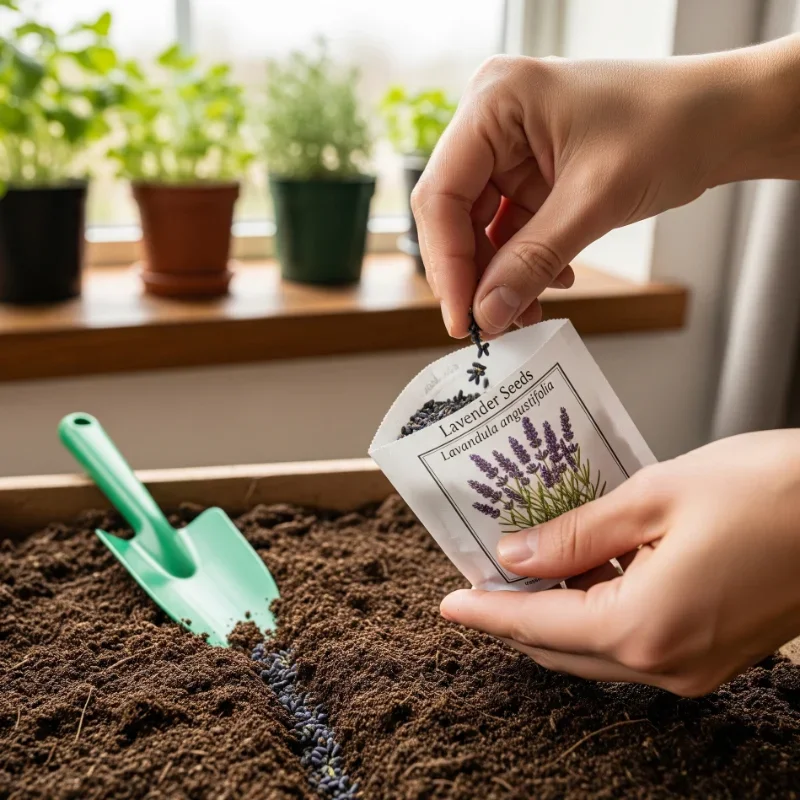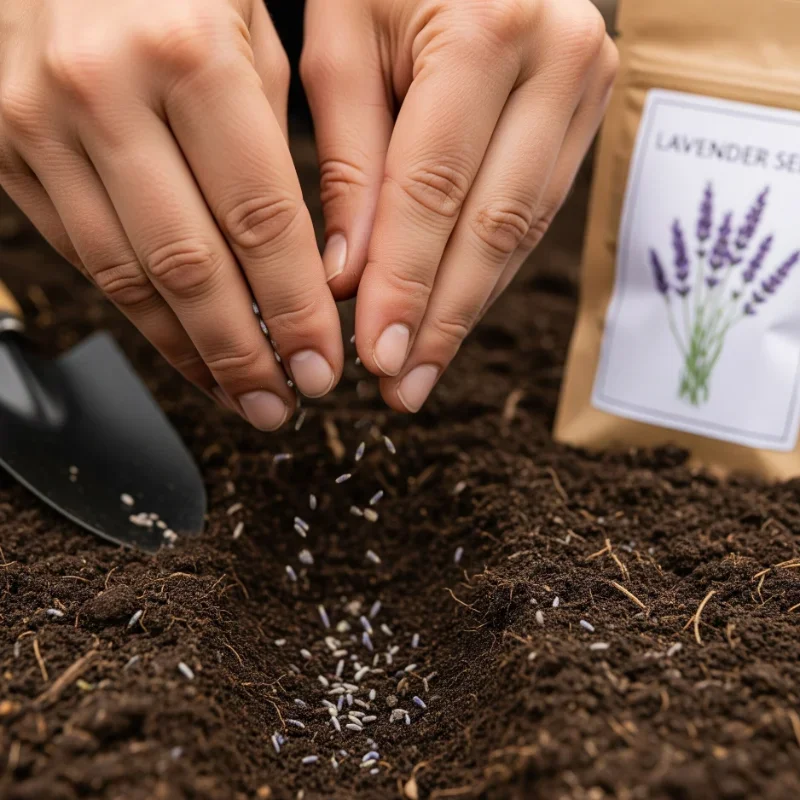How to Plant Lavender Seeds for Healthy Growth
Learn how to plant lavender seeds successfully with our step-by-step guide. From seed prep to blooming plants, master the art of growing lavender.
Oh boy, here we go! So you've decided to grow lavender from seeds, huh? Well, buckle up buttercup, because you're in for quite the adventure! While most folks take the easy route with nursery plants, you're choosing the path less traveled, and honestly, I admire your grit.
Growing lavender from seeds is like trying to teach a cat to fetch. It's not impossible, but it sure ain't gonna be a walk in the park! These Mediterranean divas can be finicky little things, demanding just the right conditions to grace you with their presence. But here's the kicker: once you crack the code on how to plant lavender seeds for healthy growth, you'll have bragging rights that'll last a lifetime.
Trust me, there's nothing quite like watching those tiny seeds transform into fragrant purple clouds that'll make your garden smell like a French countryside. So grab your gardening gloves, and let's dive into this purple-scented journey together!
Understanding Lavender: The Drama Queen of the Herb Garden
Why Lavender Seeds Are Such Divas
Before we get our hands dirty, let's talk about why lavender seeds have such a reputation for being difficult. You see, in nature, these seeds have adapted to some pretty specific conditions:
They need temperature fluctuations to germinate
Low germination rates are totally normal (we're talking 20-30% on a good day!)
They're slower than molasses in January
Different varieties have different quirks
Think of lavender seeds as that high-maintenance friend who needs everything just so. But hey, the best things in life require a little extra effort, right?
Choosing Your Lavender Variety
Not all lavenders are created equal, folks! When you're learning how to plant lavender seeds for healthy growth, picking the right variety is half the battle:
English Lavender (Lavandula angustifolia)
Most cold-hardy option
Classic lavender scent
Varieties like 'Munstead' and 'Hidcote' are popular
Best for zones 5-9
French Lavender (Lavandula dentata)
More heat-tolerant
Distinctive serrated leaves
Blooms almost year-round in warm climates
Zones 8-11
Spanish Lavender (Lavandula stoechas)
Showy "rabbit ear" flowers
Loves it hot and dry
Great for containers
Zones 7-10
Lavandin (Lavandula x intermedia)
Hybrid vigor makes it easier to grow
Larger plants with more oil
'Grosso' and 'Provence' are winners
Zones 5-9
The Pre-Game: Getting Your Seeds Ready to Rock
The Cold Hard Truth About Stratification
Alright, here's where things get interesting! Lavender seeds need a little tough love before they'll cooperate. This process, called stratification, basically tricks the seeds into thinking they've gone through winter. Sneaky, right?
Here's how to give your seeds the cold shoulder:
The Moist Paper Towel Method
Dampen a paper towel (not soaking wet!)
Spread seeds on half the towel
Fold it over like a seed sandwich
Pop it in a ziplock bag
The Sand Mix Method
Mix seeds with slightly moist sand
Place in a sealed container
Less chance of mold (winning!)
Refrigerator Time
30-40 days in the fridge (mark your calendar!)
Temperature should be 35-40°F
Check weekly for mold
Some folks skip this step, but trust me, your germination rates will thank you later!
Timing Is Everything
When it comes to planting lavender seeds, timing can make or break your success:
Indoor starting: 10-12 weeks before last frost
Direct sowing: After soil warms to 60°F
Fall planting: Works in mild climates (zones 7+)
Pro tip: Starting indoors gives you way more control, and let's face it, control freaks make great gardeners!
How to Plant Lavender Seeds for Healthy Growth: The Main Event
Preparing Your Seed-Starting Mix
Listen up, because this is crucial! Regular potting soil is like kryptonite to lavender seeds. These babies need:
Well-draining mix (think desert, not swamp)
Low fertility (too rich = unhappy lavender)
Slightly alkaline pH (7.0-8.0 is the sweet spot)
Here's my go-to recipe:
2 parts seed starting mix
1 part perlite or coarse sand
1 part vermiculite
Pinch of lime (if your mix is acidic)
Mix it all up, and you've got lavender paradise in a bag!
The Planting Process: Step by Step
Now for the moment of truth! Here's exactly how to plant those precious seeds:
Fill your containers
Use cell trays or small pots
Leave 1/4 inch from the top
Gently firm the soil
Moisture matters
Mist the soil surface until damp
Not waterlogged (I can't stress this enough!)
Seed placement
Place 2-3 seeds per cell
Barely cover with soil (1/8 inch max)
These seeds need light to germinate!
The cover-up
Use a humidity dome or plastic wrap
Creates a mini greenhouse effect
Remove once seeds sprout
Label everything
Trust me, you'll forget what's what
Include variety and date
Creating the Perfect Environment
Temperature and light are your new best friends:
Temperature: 60-70°F is ideal
Light: Bright indirect light or grow lights
Air circulation: Prevent damping off disease
Some gardeners swear by heat mats, but honestly? Room temperature works just fine if you're patient.
The Waiting Game: Germination Station
What to Expect When You're Expecting (Seedlings)
Okay, real talk: lavender seeds are slowpokes. We're looking at:
Germination time: 14-30 days (sometimes longer!)
Sporadic sprouting: They won't all pop up at once
Low success rate: Celebrate every sprout!
During this time, you'll need nerves of steel. Resist the urge to:
Overwater (the kiss of death)
Dig around looking for signs of life
Give up too soon
Troubleshooting Common Issues
When things go sideways (and they might), here's your game plan:
No Germination After 30 Days
Check seed viability (old seeds = no go)
Verify stratification was done properly
Ensure temperature is consistent
Damping Off Disease
Improve air circulation immediately
Reduce watering
Sprinkle cinnamon on soil (natural antifungal!)
Leggy Seedlings
Move closer to light source
Add supplemental lighting
Lower temperature slightly
Nurturing Your Baby Lavenders
The First Few Weeks
Congratulations! You've got sprouts! Now what? These tender babies need:
Careful watering: Bottom watering is best
Good airflow: Remove humidity dome
Bright light: 14-16 hours daily
Cool temperatures: 60-65°F
Think of them as newborns. They're delicate, demanding, and totally worth the effort!
Feeding Your Seedlings
Here's where lavender gets weird. Unlike most plants, they actually prefer being a bit hungry:
Wait until true leaves appear
Use diluted fertilizer (1/4 strength)
Feed every 2-3 weeks max
Too much food = leggy, weak plants
The Thinning Process
This part hurts, but it's necessary:
Wait until seedlings have 2-3 sets of true leaves
Choose the strongest seedling per cell
Snip others at soil level (don't pull!)
Say a little prayer for the fallen
Transplanting: Moving Day!
Hardening Off: Tough Love Time
Your pampered indoor babies need boot camp before facing the real world:
Week 1: 1-2 hours outside in shade
Week 2: Gradually increase time and sun exposure
Watch for: Wilting, sunburn, wind damage
Bring inside: If temperatures drop below 50°F
This process can't be rushed. Trust the process!
Preparing the Garden Bed
Location, location, location! Lavender needs:
Full sun: 6-8 hours minimum
Excellent drainage: Raised beds are fantastic
Lean soil: Amend clay with sand and gravel
Good air circulation: Space plants properly
Soil Preparation Steps
Test pH (aim for 6.5-7.5)
Add lime if needed
Mix in coarse sand or perlite
Create mounds for extra drainage
The Transplanting Process
The big day has arrived! Here's how to do it right:
Timing: Late spring after frost danger passes
Spacing: 12-24 inches apart (variety dependent)
Planting depth: Same level as in containers
Water in: Just enough to settle soil
Mulch: Gravel or sand, not wood chips
Long-Term Care for Lavender Success
First Year Care
Your first year is all about establishment:
Watering: Deep but infrequent
Pruning: Pinch flowers first year (I know, it hurts!)
Winter protection: Mulch in cold climates
Patience: They're building roots!
Ongoing Maintenance
Once established, lavender is surprisingly low-maintenance:
Spring pruning: Cut back 1/3 of growth
Summer harvest: Cut stems just as flowers open
Fall prep: Stop fertilizing by August
Winter care: Ensure good drainage
Common Problems and Solutions
Even established lavender can throw tantrums:
Root Rot
Improve drainage ASAP
Reduce watering frequency
Consider replanting in raised beds
Woody Growth
Regular pruning prevents this
Never cut into old wood
Replace overly woody plants
Poor Flowering
Usually too much nitrogen
Ensure full sun exposure
Check soil pH
Advanced Tips for Lavender Seed Success
Creating Your Own Seed Bank
Once you've mastered growing from seed, why not save your own?
Harvest when seed pods are dry
Store in cool, dry place
Label with variety and date
Use within 2-3 years
Experimenting with Different Varieties
Don't put all your eggs in one basket:
Try multiple varieties simultaneously
Keep detailed notes
Compare germination rates
Find what works in your climate
Container Growing
No garden? No problem!
Choose pots with drainage holes
Use extra-gritty potting mix
Water less than garden plants
Bring inside if zone 6 or colder
The Sweet Rewards of Success
When you finally see those purple spikes swaying in the breeze, you'll understand why learning how to plant lavender seeds for healthy growth was worth every moment of frustration. The benefits are endless:
Aromatherapy: Natural stress relief
Culinary uses: Lavender cookies, anyone?
Crafts: Sachets, wreaths, potpourri
Garden beauty: Attracts pollinators galore
Personal satisfaction: You grew this from seed!
Conclusion
Well, there you have it, folks! Everything you need to know about planting lavender seeds for healthy growth. Sure, it's not the easiest path to a lavender-filled garden, but nothing worthwhile ever is. With patience, proper technique, and maybe a little luck, you'll transform those tiny seeds into thriving plants that'll perfume your garden for years to come. Remember, every master gardener started somewhere, and your lavender journey begins with that first seed!
Read next: How to Prune Lavender for Healthier Growth
Frequently Asked Questions
Q1: How long do lavender seeds take to germinate?
A: Typically 14-30 days, sometimes longer with proper stratification beforehand.
Q2: Can I plant lavender seeds directly in the garden?
A: Yes, but indoor starting gives much better success rates overall.
Q3: Why won't my lavender seeds germinate?
A: Common causes include old seeds, skipping stratification, or overwatering.
Q4: When should I start lavender seeds indoors?
A: Start 10-12 weeks before your last expected frost date.
Q5: How many seeds should I plant per pot?
A: Plant 2-3 seeds per cell, then thin to strongest seedling.






